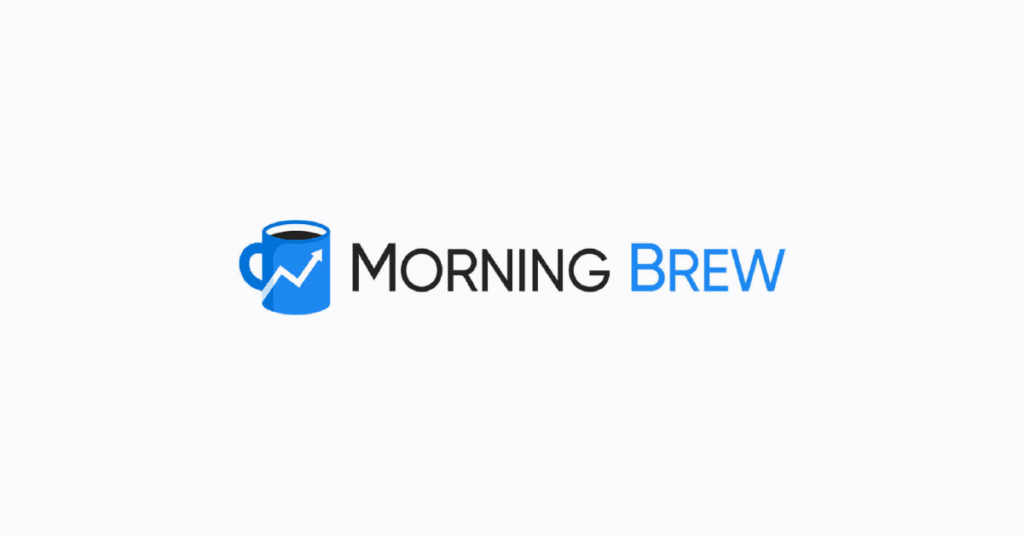
Apr 21, 2021 | newsroom
US eCommerce grew 32% in 2020, fueling demand for digital shopping know-how and logistics expertise. ShipHero is one of a number of companies trying to meet that demand by outsourcing eComm fulfillment and warehouse management for brands.
ShipHero’s cofounder and CEO Aaron Rubin told Retail Brew that revenue more than quadrupled YoY to $22 million in 2020, up from $5 million in 2019. The company also shipped $5 billion in orders last year, up from $1.7 billion the year before. Rubin said most of this came from growth among existing customers, not new ones.
The company offers two primary services to brands: 1) cloud-based software that helps brands run warehouse operations and 2) a fulfillment service that ships eCommerce orders around the country from its warehouses.
ShipHero hopes to ride the e-comm wave to close its first-ever funding round, with a $50 million goal, Rubin told Retail Brew.
Read more at MorningBrew

Apr 23, 2021 | newsroom
“From memory, it would take about four of my staff about 4-5 hours to completely fulfill 200 orders. The week we went live with Shiphero we did the same amount in about 2 hours – as of right now, even less.” Jordi Anger, CoFounder of E-Commerce Xpress.
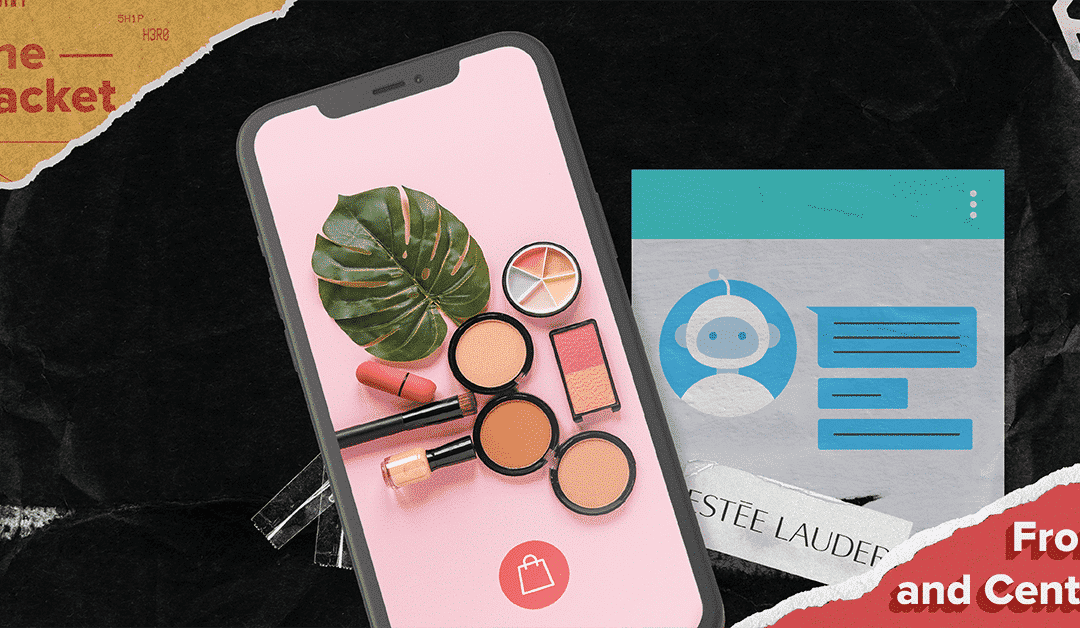
Apr 23, 2021 | Blog, The Packet
Beauty is in the i…Phone
The Beauty industry, as well as the fashion & apparel industry, were amongst the hardest hit sectors during the pandemic. Due to the fact that these industries rely on in-person brick-and-mortar shopping to browse their high number of SKUs, find the right fit, and test product quality, the beauty industry has struggled to adjust to the digital shopping experience. Until now.
Estée Lauder Co. Goes Digital in a Big Way
While traditionally relying on in-person samples and consultations, Estée Lauder Co. (ELC) has begun to rethink digital shopping. This week, Clinique (an ELC brand) quietly launched a new site in the UK, which features video chat consultations, product demos using augmented reality, the ability to shop based on product preferences, skin types and recommendations based on user data. Soon, they will roll out a feature for friends to shop together online from various locations, customize their own storefronts and control their digital shopping journey from end-to-end.
Nicky De Simone, enterprise marketing and transformation at Estée Lauder Companies, says “One of the things shoppers love about going to the store is that social connectivity. As much as we have pivoted digitally, we were still losing the customer along the way. [We] will leverage data to route a consumer’s consultation through to the right consultant for them and who will be able to make smarter recommendations.”
Tech FTW
Personalization has been a major e-commerce trend for many industries (think: supplements), due to the widespread ability to collect personal information and deliver services and recommendations based on consumer preferences. Beyond big data, other emerging technologies like augmented reality, virtual reality, chatbots and personal assistants are creating new avenues for brands to engage with their customers at scale. Companies like L’Oreal have made big investments when it comes to digitizing their shopping experience.
But is There More to Life Than Being Really, Really, Ridiculously Good-Looking?
No.
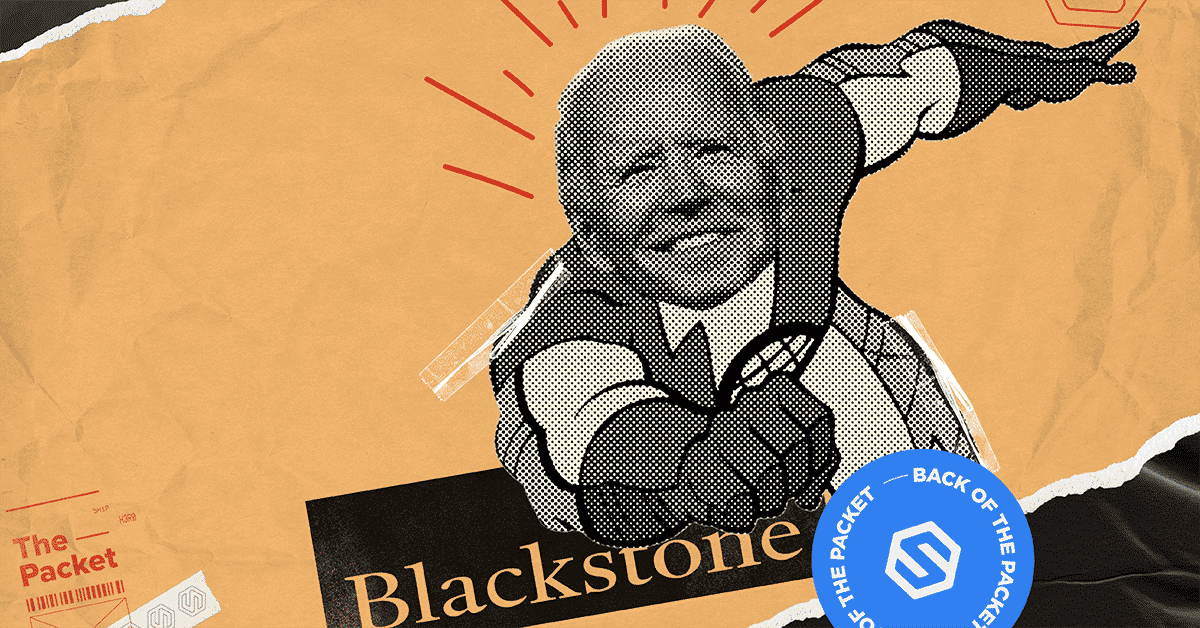
Blackstone Bets On India E-Commerce
Already the largest owner of office buildings in India, Blackstone Group Inc., has now publicized plans to become the country’s largest owner of warehouses, as well. While e-commerce continues to rise in India, the investment firm plans to spend $720 million to purchase 3.5 million square feet of industrial warehouses, as well as 18 million square feet of development sites that could be used for fulfillment and logistics properties.
Captain Planet At It Again
Before hosting the upcoming global climate summit (which falls on Earth Day) with world leaders from China, India, and more, President Joe Biden pledges to reduce U.S. greenhouse gas emissions by at least 50% by 2030, more than doubling the previous agreement under the 2015 Paris Climate Accord. in the latest push by the administration to aggressively combat climate change. This pledge comes after more than 300 businesses called on President Joe Biden earlier this month to readjust their gas emission targets.
ShipHero News
You’ve Got a BariatricPal in Me
Gym bros, swoll-mates, keto cadets, dieteers ‘til you die … no matter what you call it, weight loss and fitness is a lot more fun and successful when you have a trusted companion. That’s exactly how this eCommerce CEO’s voyage started — while embarking on his own health journey, Alex Brecher, CEO of BariatricPal, recognized the need for support, connection, and community, and launched the BariatricPal store to provide the bariatric community with high-quality food, snacks, vitamins and health accessories. Learn more about Alex’s journey in our latest case study.
Amazon FBA v. FBM
What is Fulfillment-by-Amazon (FBA) & Fulfillment-by-Merchant (FBM)? What are the pros/cons of each? How do they compare/contrast and which one right for my business, if any? Let’s dive in.

Apr 27, 2021 | newsroom
When a transaction goes well, gig companies can provide a level of service the parcel giants can’t, according to Aaron Rubin, CEO of e-commerce fulfillment startup ShipHero. He points to the difference in experience. Beyond same-day service, gig startups often offer live tracking and text updates for each order. The delivery workers knock on the door and (pre-COVID) hand orders to customers‚ creating contrast with opaque and sometimes theft-prone deliveries offered by traditional carriers.
“You’re starting to see more Amazon packages show up at your door, more Grubhub, Doordash … where it’s this fantastic experience. And that opens your eyes to, well, this is the way the world could be. Why is it not like that?” Rubin said.
Read more at Business Insider
Read more at Markets Insider
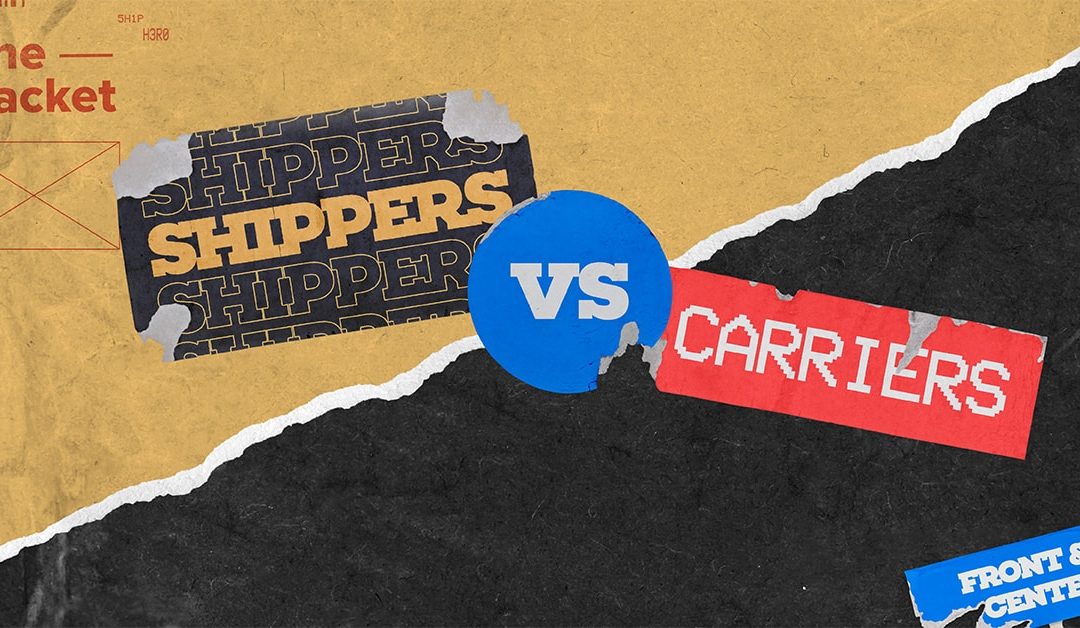
May 3, 2021 | Blog, The Packet
Front and Center
SHIPPERS VS. CARRIERS
When maritime consultant Drewry interviewed large shippers to gauge the health of the logistics industry, several shippers were very open to the fact that the relationship between shippers and carriers has been severely strained, and in one case, “at an all time low”.
What’s the difference again?
The shipper is the company who owns the goods that are shipped (also called the consignor). The carrier is the company that transports goods on behalf of the shipper, and is responsible for the goods during transit.
Got it. And what’s the beef?
According to shippers, carriers are taking a “short-sighted” approach by taking advantage of the recent spike in demand, and in so doing tarnishing long-standing relationships.
“Relationships with carriers count for nothing these days,” said one large European shipper. “The carriers are very opportunistic and take high-rate spot shipments rather than contract shipments – it is all about money.”
They sound bitter.
They have reason to. There have been cases where carriers do not honor their contractual MQCs (minimum quantity commitments), in an effort to secure spot shipments for additional profits — spot shippers transport goods “on the spot”, not through a contract, and therefore can charge an extra premium for the service. Additionally, carriers have recently chosen to cancel trips altogether in the U.S. to find greater profits elsewhere, leaving shippers scrambling to find spot shipments or NVOCC (Non-Vessel-Operating Common Carrier) which always charge a higher price.
Someone should help them work it out.
Well, the European Shippers’ Council has voiced their concerns to the European Commission, asking for an investigation into the carriers’ allegedly predatory behaviors. We hope they’ll hug it out soon.
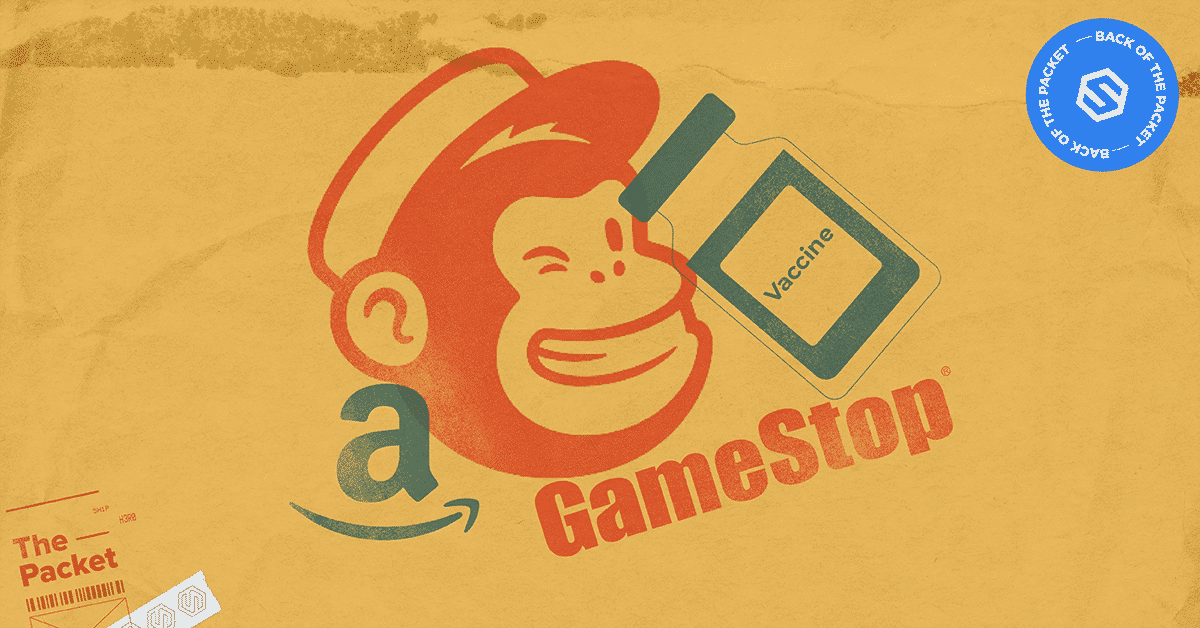
Back of the Packet
Evolution: From Mailchimp to …
Websitechimp. The widely-used newsletter platform turned marketing company, MailChimp, has announced new services to further service their growing base of e-commerce companies and rival the likes of Shopify. Mailchimp’s new “Websites & Commerce” plans lets small and medium businesses launch online stores, as well as a new appointment booking service.
Buy a Teeth Clean, Get a Vaccine
In Japan, dentists can now deliver the vaccine. That’s right, due to a lack of manpower for properly administering the vaccine to Japan’s population, there are 14 million unused doses of COVID-19 vaccines. As imports ramp up, the Japanese government faces increasing pressure to find ways of inoculating the general public. Up next, chiropractors?
????GME GOES TO THE… Venture Capitalists ????
This week, GameStop raised $551 million through an equity offering, sending its shares 15% higher in extended trading on Monday. This comes as Ryan Cohen, majority GME shareholder and owner of RC Ventuers, leads Gamestop through an e-commerce transformation to compete with other retailers in the video game space, like Walmart, Microsoft and Sony.
????AMZN DOESN’T GO TO THE MOON ????
On Monday, Jeff Bezos’s rocket company Blue Origin filed a 50-page protest challenging a $2.9 billion NASA contract to SpaceX, to build a lander for American astronauts to return to the moon. In response to the protest, Musk’s tweet points to Bezos’s possible dysfunction.
ShipHero News
Overnight Shipping
Today’s customers prefer companies that offer overnight shipping and fast delivery times. Learn how to supercharge your supply chain and offer overnight shipping to your customers, in our blog post: How To Offer Overnight Shipping + Tips For Success.
3PL vs. 4PL
What’s the difference between a 3PL and 4PL? If you don’t know, you could be missing some important information on your supply chain. Find out more about 3PLs, 4PLs, and e-commerce logistics in our recent post.

May 3, 2021 | 3PL Warehouse Management, Blog
The success of any business rests in the hands of the customer. If your customers aren’t happy, they won’t purchase your products or recommend your company. This leads to a reduction in sales that can ultimately drive your business into the ground.
There are many factors that come into play when dealing with customer satisfaction, but one of the biggest is the order fulfillment process. The speed and accuracy with which orders are fulfilled is one of the biggest determining factors in customer satisfaction, but it is also one of the most challenging aspects of running a business. To simplify and streamline this process for reduced costs and improved customer satisfaction, many businesses turn to 3PL providers and 4PL providers to improve their logistics strategy and expand their fulfillment capabilities.
In order to truly understand the difference between third and fourth-party logistics, you first need to understand the basics of how outsourced logistics works. Keep reading to find simple definitions of 1PL, 2PL, 3PL, and 4PL, followed by an in-depth look at the difference between third-party and fourth-party logistics.
A Review of Logistics Terminology
An online retailer has a wide variety of options when it comes to fulfilling orders. Choosing the right logistics provider is the key to optimizing your supply chain and maximizing both profit and customer satisfaction. If you make the wrong choice, it could end up costing your company thousands, even millions, of dollars, not to mention end up hurting your customer satisfaction rating as well.
Before getting into the specifics of third-party versus fourth-party logistics, here’s a quick review of logistics terminology to put things in context:
- First-Party Logistics (1PL) – A model in which the retailer sends products from one location to another. For example, a farmer delivering eggs directly to a grocery store for sale.
- Second-Party Logistics (2PL) – A provider that owns assets to transport products from one location to another. For example, a farmer might hire a courier (2PL) to transport eggs from the farm to the grocery store for sale.
- Third-Party Logistics (3PL) – A provider that retains oversight of the management process but outsources transportation and logistics to an outside provider. The company may also subcontract some or all of the execution of the supply chain and may provide additional services such as packaging to add value. For example, a farmer might hire a 3PL to pack the eggs in cartons and to transport them from the farm to the grocery store for sale.
- Fourth-Party Logistics (4PL) – A provider that outsources the management of logistics activities in addition to the execution of the supply chain. These providers usually offer greater strategic insight and management. For example, a 4PL might manage communication with a farmer to increase egg production as the grocery store’s inventory declines.
- Fifth-Party Logistics (5PL) – A provider that develops an optimal supply chain network with innovative and customized logistics solutions. These providers use technology such as robotics, automation, and RFID devices to improve efficiency and value along the entire supply chain.
In the above overview, the egg and farmer business is a hypothetical example that could be applied to any eCommerce business.
Every business has its own unique needs for supply chain logistics. For medium to large-sized businesses, however, it usually comes down to choosing between third-party and fourth-party logistics providers. Keep reading to learn the basics of both and to receive some tips for making the best choice for your company.
Understanding the Basics of Third-Party Logistics
Simply put, a third-party logistics provider is a model that involves three separate parties. The first is the business itself, the second the logistics provider, and the third is the carrier. In this supply chain model, the business turns over logistics operations for inventory storage, packaging, and managing inventory as well as turning it over to the carrier for shipment. Another way to think of it is that a 3PL becomes the middleman between the business and the shipping carrier, taking care of the tedious aspects of shipping.
This supply chain model has been around since the 1970s, and the first 3PL providers were intermodal marketing companies that received packaged loads from shippers and transferred them to railroads. Today, the role of a 3PL provider has expanded to include services such as managing the movement of parts and materials from suppliers to manufacturers. It also includes transferring finished products from the manufacturer to the distributor or retailer.
In most cases, third-party logistics providers offer bundled supply chain services which may include some or all of the following:
- Warehousing & storage
- Transportation
- Cross-docking
- Inventory management & inventory planning
- Crating and packaging
- Picking & packing orders
- Freight forwarding
- Shipment tracing/tracking
- Reverse logistics (returns)
These services can be scaled and customized according to the business’s needs. Generally speaking, businesses hire 3PLs when their supply chain becomes too complicated for internal management. For example, if a small business significantly expands their inventory as sales increase or grows through a merger or acquisition by another company.
Pros of 3PL:
- They offer innovative strategies customized to your business to optimize your supply chain, making it more efficient and cost-effective.
- In most cases, 3PLs are able to reduce transportation costs by 5% to 25% compared to a manufacturer running their own shipping operation.
- They handle all regulations, both domestic and international, which makes it easier for a manufacturer to test and enter a foreign market – they also manage customs brokerage.
- A 3PL generally has the warehouse capacity to execute fulfillment from multiple locations around the country or around the world.
- It is generally cheaper to hire a 3PL provider than to purchase or lease warehouse space in markets you want to test or expand into.
- Most 3PLs offer monthly pricing instead of locking you into a long-term contract
Cons of 3PL:
- Hiring a 3PL necessitates a loss of control over your shipping functions – one of the functions that has the greatest impact on your customer satisfaction.
- Not all 3PLs offer both domestic and international logistics services – some have failed to grow and change with the industry.
- There is always a risk that a business’s relationship with a 3PL provider will become untenable which can lead to a significant loss of relevant market knowledge, making it more difficult to resume in-house management of shipping functions, if necessary.
- The cost to hire a 3PL is not always clear or up-front – it may be cheaper initially but could become more expensive than in-house management if operations expand sufficiently to allow it.
If you’re still not sure whether a third-party logistics provider is right for your business, here are some examples of industries that can benefit from hiring 3PL providers:
- Medical Devices – Medical device companies need to not only ship their products from the distribution hub to individual locations, but those shipments must be expedited and tracked through every step of the process with a chain of custody that can be easily verified. This requires complex technology which is a skill 3PL providers are able to provide.
- Field Services – Service and repair businesses can benefit from 3PL services because these services use integrated technology to create a database of commonly ordered items to ensure that inventory meets demand. Businesses can pick up parts directly from the hub or place an order for expedited delivery to the specific job site.
- Retailers – Retail businesses are now expected to offer expedited delivery to their customers due to the “Amazon effect.” A 3PL provider makes it possible to provide same-day and next-day deliveries while managing the retailer’s costs.
Hiring third-party logistics companies could help you expedite your order fulfillment while also reducing costs and improving customer satisfaction. Before you commit, however, there is another option to consider – fourth-party logistics. Keep reading to learn more.
Understanding the Basics of 4PLs
In a fourth-party logistics partnership, a business is basically outsourcing the entirety of their supply chain management to a logistics service provider. The 4PL oversees all of the different pieces of their client’s supply chain including warehouses, transportation companies, and agents. The goal is for the 4PL to be the single interface for the business between all aspects of the supply chain.
You can think of 4PLs as a supply chain integrator. It’s the most comprehensive supply chain solution available for a business. A 4PL is often a joint venture for enterprises that want business planning and project management to be handled by a separate entity. For example, companies like Deloitte and Accenture offer 4PL services to their clients.
In most cases, the 4PL does not actually own warehouse or transportation assets. Rather, it coordinates these services with vendors – it may also coordinate the activities of 3PL providers that are handling various aspects of the company’s supply chain. The difference is that 3PL providers are focused on day-to-day operations while 4PL providers focus on integration and optimization. A 4PL provider may also be known as a Lead Logistics Provider (LLP).
The primary benefit of hiring a 4PL organization is that the 4PL focuses on simplifying and streamlining logistics for the highest level of services for the best value. The 4PL becomes your single point of contact for the entire supply chain which is ideal for large businesses that have complex order fulfillment operations.
Here is a quick summary of some of the benefits a 4PL provides:
- Simplicity: The 4PL acts as your single point of contact for the entire supply chain.
- Neutrality: The 4PL has no assets to protect, so they act on behalf of the client.
- Transparency: Most 4PLs have an open-book management style with no margins on transportation; costs are controlled.
- Optimization: Integrated technology and management systems ensures optimal flow of inventory and shipping processes.
- Savings: A combination of logistics sourcing and reduced transportation spending leads to substantial savings across the board.
- Productivity: Taking the weight of logistics off your shoulders expands your ability to grow the company as you see fit.
Now that you know a little more about what a 4PL does take a minute to review the potential pros and cons for hiring a 4PL provider.
Pros of 4PLs:
- A 4PL becomes the “control tower” for the entire supply chain process, managing everything from inventory to shipment.
- Most 4PLs are non-asset based which means that their entire focus is on simplifying and streamlining to logistics functions to improve value and reduce costs.
- Hiring a 4PL takes the burden of logistics entirely out of your hands with minimal oversight required, freeing you to do the things it takes to grow and expand your business.
- A 4PL can manage complex supply chain models which include domestic and international distribution, as well as managing multiple warehouse locations.
- Hiring a 4PL provider could enable your business to provide same-day or next-day shipping options for improved customer satisfaction.
Cons of 4PL:
- Hiring a 4PL provider means you are giving up control over the logistics process as well as the specific functions – you’ll be relying very heavily on an outside provider for one of the biggest functions of your business in terms of customer satisfaction.
- There is potential that the 4PL could form biases with certain suppliers instead of seeking out the most efficient or cost-effective option.
- Transitioning from a 4PL provider model back to in-house management of supply chain services could be very difficult for a large business.
If you’re still not sure whether a fourth-party logistics provider is right for your business, here are some examples of industries that can benefit from hiring 4PL providers:
Medical Devices
In the industry of medical devices, surgeons often make last-minute orders and order multiple sizes of devices since they don’t know exactly what they’ll need. A 4PL provider is better equipped to manage complex chain-of-custody requirements and tight delivery schedules while reducing inventory costs.
Field Services
Integrative technology enables a 4PL to optimize all aspects of the supply chain including determining the ideal parts, quantities, and locations based on anticipated demand. Field techs no longer have to double as warehouse operators and parts can be delivered in 30 minutes or less, improving efficiency and maximizing customer satisfaction.
Retail/eCommerce
By managing the entire supply chain network, 4PLs can allocate inventory to meet customer demand and to reduce missed opportunities. They also enable companies to provide same-day delivery regardless of location as well as same-day replenishment.
Now that you know the basics about third-party and fourth-party logistics, you may already have a sense for which one might be best for your company. Before making your choice, however, you should take a closer look at the unique differences between 3PL vs 4PL providers.
3PL vs. 4PL – What’s the Difference?
A 3PL is focused on the day-to-day operations of your supply chain logistics – it is more transaction-focused than a 4PL. That being said, a 4PL takes it a step further by optimizing your entire supply chain, including any 3PL providers your business might have hired. They take over the entire operation and become your single point of contact which leaves you free to pursue other things that might help grow and expand your business.
When an organization already has an effective, high-performance supply chain strategy in place, a 3PL provider can provide the extra support needed to execute that strategy efficiently. This type of relationship usually requires a significant degree of internal management to ensure that the 3PL’s performance meets business standards. While the day-to-day functions may be out of your hands, you still need to retain a certain degree of oversight. You should also keep in mind that because 3PLs are asset-based, some companies may be more concerned with utilizing their own assets than with providing competitive rates or more valuable services.
A fourth-party logistics provider is non-asset based which means that their focus is on finding the ideal combination of service and value. These providers utilize integrated technology to ensure a high level of visibility across the entire supply chain for both strategic and tactical analysis. Your business will still need to utilize some internal resources to oversee and manage 4PL performance, but it takes most of the weight off your shoulders when it comes to optimizing services and minimizing costs.
There are a lot of factors to consider when it comes to choosing between a 3PL and a 4PL, so be sure to do your research before you decide. Keep reading to receive some simple tips to employ as you start making your decision.
What’s Best for Your Company?
Know that you understand a little more about third-party and fourth-party logistics and how they differ, which option is best for your company? Unfortunately, there may not be a clear-cut answer. You’ll need to take a deeper look at your business operations to see where you are struggling and whether hiring a 3PL or 4PL provider might help.
Here are some of the signs that your company could benefit from hiring a 3PL provider:
- Your business is a startup manufacturer or B2C company in the range of $1 to $5 million.
- Your business’s ability to produce and sell good is outpacing your ability to store and ship them.
- You are spending too much time fulfilling orders when you could be focusing on factors that influence the growth of your business (e.g. marketing).
- Your customer satisfaction levels are falling due to poor shipping and return practices.
For many businesses, hiring a 3PL provider is the first step as the business grows and expands. Over time, however, it might make more sense to move to a fourth-party logistics model. If your business has outgrown your in-house capacity for managing supply chain services and you want to optimize the entire process for efficiency and controlled costs, you may do best with a combination of 3PL and 4PL providers. The benefit of hiring a 4PL is, of course, that you can also gain the benefit of 3PL services without having to manage them yourself.
Whether you are hiring a 3PL or a 4PL provider, you need to do your research to ensure that you choose the company that is the best fit for your business. Take the time to delve deep into each company’s set of skills as well as their experience and reputation in the industry. You’ll be turning over a significant portion of your business’s essential operations, so you need to choose a provider you can trust 100%.
Choose ShipHero as your 3PL
ShipHero is a leading 3PL service for ecommerce merchants. We handle logistics and fulfillment for over 4,000 online stores.
Reduced shipping costs
Due to our partnerships with major carriers, merchants working with ShipHero get reduced shipping costs for each order. Even better, our use of distributed fulfillment centers means you save even more money on transit costs and can get orders delivered faster.
2-day delivery and overnight delivery
With ShipHero’s distributed fulfillment network, orders can be delivered to most locations with 1 to 2 days. This allows you to offer the same delivery speeds that Amazon does, without having to let Amazon’s FBA fees reduce your profits.
Fulfillment for all your sales channels
We don’t just handle fulfillment for your Amazon orders. In addition to Amazon, ShipHero handles multi-channel fulfillment for Walmart, eBay, Shopify, BigCommerce, and most other eCommerce sales channels.
Conclusion
Every business is unique in terms of the services it provides, but all businesses have the same basic needs. Optimizing your supply chain process for reduced costs and improved customer satisfaction should always be a priority and hiring a 3PL or 4PL provider could be your next step to doing so.
Need a warehouse management system (WMS) for your 3PL? ShipHero’s 3PL services will help your eCommerce store run at full potential.

May 4, 2021 | newsroom
A key component of micro-fulfilment is rethinking the role of the retail store, which now needs to function like a warehouse and bricks-and-mortar shop, says Maggie Barnett, COO of ShipHero, the fulfillment network partner for Shopify. “Some of our large beauty and fashion brands have a prolific real estate footprint, so they want to leverage that — even if people aren’t necessarily visiting those stores at 100 per cent capacity,” Barnett says.
Read more at Vogue Business
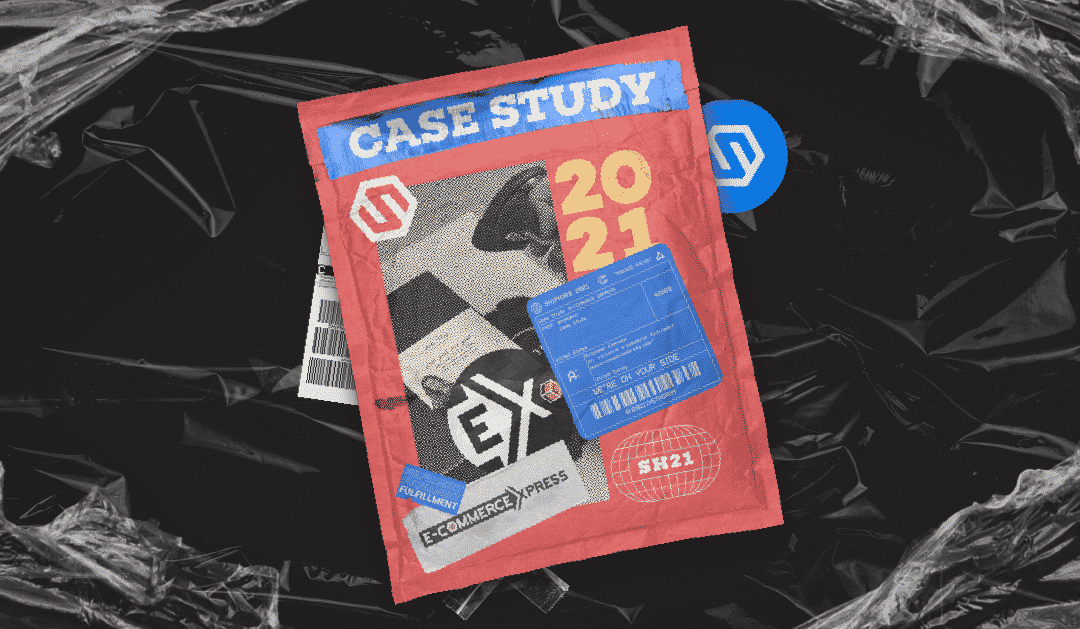
May 5, 2021 | Blog
*Takes dramatic drag of cigarette* What does it mean to be in good company? In essence, it’s simply a group of people bonded together by common ideas and shared values. In a business sense, a company is only as good as the glue that holds it together, bonded through a shared mission, a vision to strive towards, and the belief that the joint effort of a company will result in prosperity well beyond the capacity of an individual.
So what happens when the frustrations start to mount, and your business is brought to the very brink of “do or die”. Well that’s what happened for E-Commerce Xpress, a third party logistics (3PL) provider located in South Queensland, Australia that specializes in guiding small to medium-sized businesses through the initial growth phase of logistics — ranging from women’s apparel and winter clothing, to home gym equipment (booty bands, resistance bands, water bottles, etc).
>”Shipping 200 orders felt like such a struggle. Our staff definitely shared the frustration. To put it in perspective there was one fairly high volume period where in an 8 hour shift, someone tracked 12.5km on their Fitbit for the day.” E-Commerce Xpress Cofounder and GM
12.5km … for those of us not on the metric system, that’s about one third of a marathon. After this particularly stressful event, the good people at E-Commerce Xpress decided it was time for a hero to sweep them off their aching feet — a ShipHero that is. We were enticed by their story and sat down with Anger, Jordi Anger, Cofounder and GM of E-Commerce Xpress. Here’s our interview.
ShipHero: Mr. Anger, could you please calmly provide a brief description of your business 🙂
“We are very simply a 3PL/fulfillment centre located in South Queensland, Australia. We specialise in fulfillment and inventory management for small to medium-sized e-commerce brands who are going through those initial growth phases in the logistics side of their business.
The local brands are starting a lot of eco-friendly, earth-conscious based products/brands, and we also see a lot of Swimwear and Cosmetic type business, probably due to the renowned sunny weather we have here!
Our goal is purely to ensure that their customers have the best possible journey behind the ‘Pay Now’ button and provide the best and most flexible service possible for our clients.”
Before switching to ShipHero, what were the challenges that made you want to just rip your hair out?
“We were using another 3PL company, which initially sounded like the best suit for us at the time. Unfortunately, the transparency was not there and by the time we had switched to live we found that we couldn’t use their product to its fullest potential.
“As a result we had to go pay for a completely separate platform just to be able to generate labels and ship orders. So we couldn’t pick Multi-batch, we had to become a paper reliant warehouse, we couldn’t fulfill orders through the one system and we had next to no support, which are all the things we were initially sold on.
The main frustration was that–”
Uh oh.
“Anyway, the main frustration was that because of this, the time it took to ship 200 orders for example was ridiculous. From memory it would take about 4 of my staff about 4-5 hours to completely fulfill 200 orders. My staff definitely shared the frustration.
“To put it in perspective there was one fairly high volume period where in an 8 hour shift, someone tracked 12.5km on their Fitbit for the day. This was simply because the walk-time they had to do for each order was essentially the same each time due to not being able to use the multi-batch order feature.”
And… how did that make you feel?
“Agitated”.
Phew. How about after the switch to ShipHero?
“The week we went live with ShipHero we did the same amount [200 orders] in about 2 hours. As of right now, even less. After the switch, the amount of efficiency we were operating at was, and still is, truly amazing. That would be our biggest area of improvement, along with now becoming a paperless warehouse which is really important to us.
“The only way this is possible is by partnering with a platform that had similar values like ShipHero. We see ShipHero as an extension of our team as well, and so far they haven’t let us down.”
Ha … we’re honestly terrified to let you down. So when searching for a fulfillment partner, what did you consider as important criteria?
“Customer service is always a must! In this industry, it’s very common for small issues to arise every day so we needed to make sure we had a really good support team by our side, and more importantly, an on-boarding team that could teach us to problem-solve ourselves!
“We also wanted a modern and easy to navigate interface that would be simple for our employees to learn as well as our clients. There are a lot of outdated WMS that we came across that are really hard to grasp.
“Finally, cost is an obvious factor. There are a lot of services out there that have a lot of hidden fees that once you start operating, it’s clear that those services are necessary.”
What made you finally choose ShipHero?
“Liam Dillon (CoFounder) and I had been watching and sharing some of ShipHero’s YouTube videos and really liked how they were explaining and demonstrating the pick-and-pack processes. We decided to do a bit more research on ShipHero and found that they have a 3PL-specific WMS platform.
“We had already had multiple meetings with other platforms but none were the right fit. ShipHero stood out to us immediately as we could see that they weren’t ‘stuck in the past’, and really provided a fun and modern aspect to 3PL and fulfilment.
“Not to mention, the pricing structure was super easy to understand and really cost efficient, which was a huge plus!”
How was the integration process with ShipHero?
“Our last WMS had a 6 week on-boarding period to get set up and learn the system, with ShipHero we were integrated in about 2 hours! This experience was super straightforward and easy.
“We essentially went live the next day after connecting our customers, and we were shipping immediately. It was the best way to learn the system as we essentially jumped straight in and learned by doing. Everyday, our onboarding manager was checking-in to see how things were going and was available via email, phone and even SMS.”
Well don’t forget that they’re still around for whenever you need to manage your … systems. Finally, how was your business impacted by COVID-19?
“We strangely launched our business throughout the COVID-19 period. We were pretty lucky here in our state that we were able to control the cases and still be able to provide essential work for the most part!
“We were also super lucky to have two amazing clients that saw the benefit in utilizing our services throughout COVID-19 as their industry skyrocketed during this period. Liam already had a really good relationship with them previously so we were able to help them control their growth and provide an awesome service whilst they allowed us to grow with them and quickly build our operations into what it is today!”
Amazing. Final thoughts, comments, words of praise, or outbursts?
“In summary, we are super lucky to be able to partner with ShipHero, who is focused on continually making changes to benefit their users! I feel like every month there are new and updated features which might not seem like a big deal but benefit our warehouse processes dramatically.
“We have been able to scale back our costs, time and effort ever since partnering with ShipHero, which at the end of the day has allowed us to focus on growth and perfecting our business’ services and operations.”
Follow Liam and Jordi and hop on the E-Commerce Xpress at their website and Facebook.
https://e-commercexpress.com/
https://www.facebook.com/E-commerce-Xpress-107514591393563
https://www.instagram.com/ecommercexpress_/
Want to be featured in our case study?
If you would like to share with us stories about your eCommerce experiences, whether it’s how you started your business, what opinions you have on the stories we share, or if you just feel like venting… we’re here for you.
Shoot us an email and you could be featured on an upcoming Case Study, our critically-acclaimed weekly news segment The Packet, or if you’re lucky, you could be invited to join one of our many Podcast episodes!
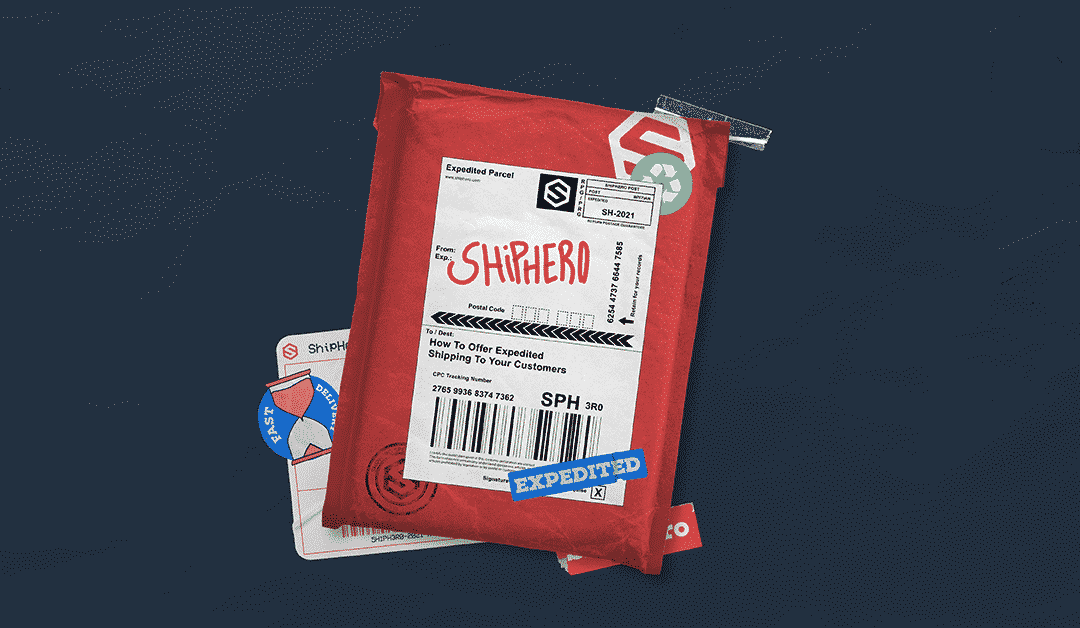
May 6, 2021 | 3PL Warehouse Management, Best Practices, Blog, Warehouse Management Software
With the ecommerce industry growing rapidly, many things about the field have seen significant improvement in the past few years. Companies have been working to ensure a better customer experience with improved technology and better shipping options. Quick delivery times with low shipping costs are vital to optimize customer satisfaction levels. But how can you offer faster shipping times without compromising profits?
The topic of faster shipping brings us to expedited shipping and the advantages it offers over standard shipping services. Here’s what ecommerce retailers should know about the workings of expedited shipping.
What is expedited shipping?
Expedited shipping refers to shipments that are faster than the standard option for delivery. The actual term means different things for different carriers and can refer to one-day or two-day delivery options. As such, expedited shipping charges to domestic or international destinations vary with the various delivery services.
How fast is expedited shipping?
Different delivery options with various carriers usually come with their specific strategy for the whole supply chain. Depending on the type of product and the shipping zone distance between the point of origin and destination, the delivery times of expedited shipping can vary with each carrier.
Is expedited shipping worth the added cost?
The expedited service option usually comes with added cost for the lesser delivery times that increase with the shipping zone distance and the parcel’s weight and dimensions. Some businesses hold customer satisfaction in high regard and feel that the expedited shipping option is worth it. Of course, faster delivery times add to the whole charm of the sale for the customer and can increase your company’s revenue.
The differences between expedited and standard shipping
Standard shipping usually costs the least when it comes to different delivery services. The standard service could translate to a two-day shipping time for some companies, while others might offer longer delivery times for their standard shipping. The standard delivery option for one of the most popular carriers in the US, the USPS, consists of ground shipping and usually takes more than two business days for farther shipping zones.
Reasons to offer expedited shipping
Expedited shipping provides a guarantee to your customers that their packages will be shipped in reduced transit times. This reduction in transit time directly increases customer satisfaction, and it is arguably one of the most important reasons businesses opt for this shipping method. However, there are other advantages to expedited shipping as well.
To save time
The primary purpose of expedited shipping is to save on shipping time. Carriers often do this by minimizing the supply chain to the final destination. If your customers are willing to pay more for faster shipping, expedited shipping is the suitable business method for your setup.
Shipping perishables
Many perishable items like frozen food and baked items require faster shipping so that the products do not expire during the shipping process. For this reason, expedited shipping is the correct answer for your business if you are involved with the food industry.
To win (or retain) customers
If most of your customers opt for faster shipping methods and are willing to pay the extra cost, then you should look into making expedited shipping into your standard shipping option. There is a chance that retailers might lose customers who want faster shipping if they don’t offer expedited shipping.
Save on storage costs
Taking the products from the manufacturers and storing the inventory in warehouses often comes with detailed storage charges. When you offer expedited shipping, the products spend less time in storage, and you can save on inventory storage costs.
Reduce abandoned carts
Unsatisfactory delivery options directly link to cart abandonment among prospective customers. Having various shipping options such as expedited and standard shipping lets the customers choose the shipping option they like. Therefore, it’s wise to offer expedited services to your customers.
Meet customer expectations around ship time
Customers usually look at a couple of retail options before buying something, and they often go with the retailer that provides convenient delivery options. Today, faster shipping methods like Amazon’s next-day delivery options have increased customer expectations, and this is why not having expedited shipping could hurt your sales.
Build customer loyalty
Customer satisfaction is the key to getting repeat customers and building customer loyalty. When the customers get their parcels delivered faster, they are more likely to purchase from your shop again in the future. Offering expedited shipping options could enhance the customer loyalty in your consumer base and possibly secure future sales.
How fast is expedited shipping compared to other fulfillment options?
Different delivery services come with different standard and premium delivery times. Let’s look at some of the popular shipping options and how they fare compared with expedited shipping.
Expedited shipping vs. standard shipping delivery speeds
Standard shipping services are often the cheapest shipping option out there, but they also take many business days to deliver the package, depending on the shipping zone distance. On the other hand, expedited shipping offers reduced shipping times while being more costly. Some companies have two-day delivery as their standard shipping options, while others take longer in their standard delivery service. These options vary from company to company.
Expedited shipping services vs. express shipping delivery speeds
Depending on what carrier service you are looking at, expedited and express delivery can be used interchangeably or mean the same thing. Couriers usually have a variety of standard and premium delivery options, and these terms vary depending on their context of use.
Two-day (or next-day) shipping
For some companies like Amazon Prime, two-day shipping options are standard, while for others, two-day delivery often falls under the umbrella of expedited shipping. Like the other terms, these terms also vary with each courier.
Which shipping carriers offer expedited shipping?
Many carriers offer different expedited shipping services like flat-rate shipping, ground shipping, and next-day air shipping options. Let’s look at some of the most popular carriers in the US and their expedited shipping services.
USPS expedited shipping
USPS is among the most popular courier services in the US for domestic delivery. A popular expedited shipping option by USPS is their Flat Rate Priority Mail Express. This mail service comes with options like overnight and next-day delivery options, and you can track the parcel during shipment.
UPS expedited shipping
UPS is another shipper that offers expedited shipping options for domestic delivery, including same-day, next-day, and two-day shipping guarantees. The UPS Worldwide Expedited service offers faster delivery to international destinations.
FedEx expedited shipping
FedEx also provides several expedited shipping options based on the package’s size and dimensions, destination, and urgency. These shipping options include FedEx Express Saver, and FedEx Expedited Freight, and the FedEx Same Day service.
How to offer expedited delivery
It might seem that expedited delivery is impossible for small businesses to offer and might kill your budget. But there is a way to provide expedited delivery without any extra burden on your budget – and here’s how.
Use distributed fulfillment centers
Having your inventory stored in multiple fulfillment centers means that you can minimize the shipping zone distance from the warehouse to the destination. This way, you can use ground shipping methods from the nearest warehouse for the expedited shipping option.
Require a minimum purchase amount for orders
To cover the shipping costs for expedited shipping, a smart thing to do is set a minimum order purchase threshold. This way, you can cover the marginal shipping cost from the products’ revenue while keeping your customers happy.
Work with an experienced 3PL
Another way to save on shipping costs is to work with an experienced third-party logistics (3PL) company that can get you discounted shipping rates with major carriers. Other than the discounted shipping rates, a 3PL can help cut back on shipping costs by making the process more efficient. Experienced 3PL partners offer shipping options and technology that you might not have been able to manage on your own.
Offer expedited shipping with ShipHero
By now, you understand the importance of expedited delivery and why it pays off to offer your customers multiple shipping options. With ShipHero, you can offer different types of expedited-delivery options like overnight or two-day delivery services, depending on your customers’ needs and your company’s budget.
Outsourced fulfillment
ShipHero partners up with 3PL companies to offer you discounted shipping rates and distributed fulfillment options so that you can reduce shipping times and shipping rates in one go.
Distributed fulfillment centers
ShipHero lets you distribute your inventory across the nationwide network of fulfillment centers. Having distributed fulfillment centers all over the country means that you can minimize the shipping zone distance to the. What this means is that you can offer faster shipping to your customers with the help of on-ground shipping methods.
Save on shipping costs
ShipHero offers you different courier services to partner up with, and some of them offer discounts on the shipping rates. This way, you can save on shipping costs and choose the carrier that works best for you. As a plus, there are no hidden shipping fees, and users get precisely what they pay for.
Conclusion
Expedited shipping sure has its advantages, but it can also seem like a very costly option. Now that you have looked at how you can realistically offer expedited shipping options to your customers without breaking the bank, it’s time to get things going. ShipHero lets you offer expedited shipping by connecting your ecommerce platform to trusted carriers with various shipping options and discounted rates.
If you’re looking to provide customers with premium shipping options without breaking the bank, then check out ShipHero.
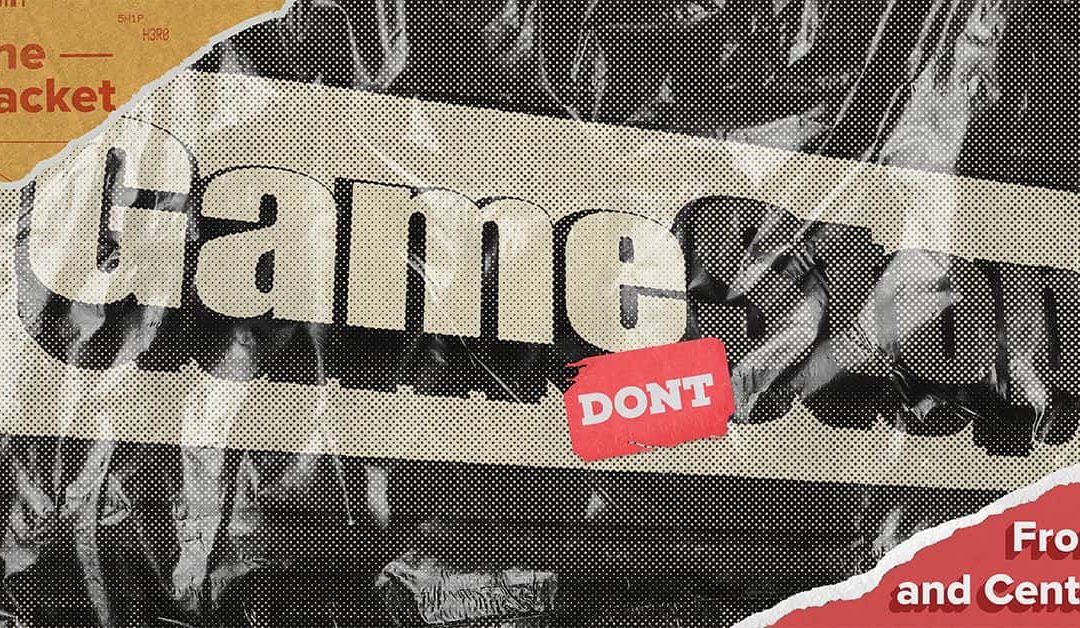
May 7, 2021 | Blog
Front and Center
The Game (Won’t) Stop
Since taking the reins of the prolific video game distributor back in January, Ryan Cohen, co-founder of online pet food company Chewy Inc, has made quick work of fast-tracking GameStop’s e-commerce capabilities. The company announced Monday that it will expand its fulfillment network with a 700,000 sq-ft facility on, you guessed it, the moon. Jk close though, it’s in York, Pennsylvania
“This facility is expected to be operational by the fourth quarter of 2021 and will support e-commerce and fulfillment needs,” the company said in a news release. “The Company expects its fulfillment center in York, Pennsylvania will position it to grow product offerings and expedite shipping across the east coast.”
New Player Has Entered Chat
Beyond building out its fulfillment network, Cohen has ousted the former C-suite and ushered in a new team of current and former Amazon employees to support the transformation. Despite the recent stock market saga that captured the hearts of many Reddit users, the GameStop brand remains strong in the video game space, and this switch could further bolster the companies earnings. In fact, GameStop recently reported that its global e-commerce sales surged 175%, representing 34% of net sales in the fourth quarter of fiscal 2020.
The New Age of Brick-and-Mortar
Even before the pandemic, it seemed that physical brick-and-mortar retail stores were a thing of the past and soon to be outdated. The yearlong lockdowns may have expedited things a bit, but the reality was/is that retailers were scrambling to find a way to utilize their large real estate footprint.
Retail Tycoon IRL
Stores like GamStop are uniquely positioned to turn their retail stores in micro-distribution centers for fast and inexpensive local delivery. And other brands are starting to do the same, as ShipHero COO Maggie Barnett explains in an interview with Vogue Business.
“Some of our large beauty and fashion brands have a prolific real estate footprint, so they want to leverage that — even if people aren’t necessarily visiting those stores at 100 percent capacity,” Barnett says.
Check out the full article here.
Back of the Packet
Mmm … Union Rings
On Wednesday, Trump-era rules were nullified that made it more difficult for a gig worker to be classified as an employee under federal law. When a gig worker is classified as an employee, they are covered by federal minimum-wage and overtime laws. It also means that these workers are better positioned to organize into labor unions — and creating union jobs has been a top priority for the Biden administration.
Ebay-bay
The eCommerce platform is looking into cryptocurrency as a payment option, as well as exploring the realm of non-fungible tokens (NFTs). And they say eBay is shady ????
Bezos News
Jeff Bezos is building a gigantic luxury yacht that’s expected to be one of the best in the world – and he’s adding a ‘support yacht’ with its own helipad. We get it, he’s single now. Bill Gates plans to get girls in attendance by pinging their newly implanted 4G chips in their arm. Moving on.

Belgium Invades France
By moving a 200 year old boulder by about 7.5 feet, a farmer in Belgium accidentally re-routed the country’s border with France — the stones were placed to mark the border after an 1820 treaty. Belgian authorities light-heartedly warn that the farmer may face criminal charges if he doesn’t return the slaaaaaaaaab.

ShipHero News
!Trigger Warning! E-commerce Case Study With Anger ????
ShipHero Case Study is back y’all and this time… it’s written with Anger! Jordi Anger that is, Cofounder Of E-commerce Xpress, an upstart 3PL that serves small to medium-sized businesses in South Queensland, Australie. All aboard the E-commerce Xpress!
“From memory, it would take about 4 of my staff about 4-5hrs to completely fulfill 200 orders. The week we went live with Shiphero we did the same amount in about 2 hours — as of right now, even less.” Jordi Anger, CoFounder of E-commerce Xpress.
Calculating Your Shipping Costs
Shipping costs have a huge impact on your bottom line. Learning how to properly calculate shipping costs and find the best shipping discounts to help your margins and improve the customer experience. Stop overpaying for shipping today, with our latest blog post: Shipping Costs: Calculators, Discounts & More.













